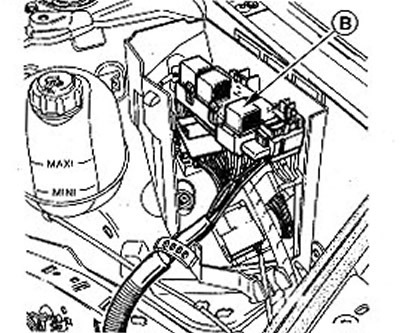Attention! Diesel engines require a compression gauge with a large measuring range up to almost 40 bar.
The pressure difference in the individual cylinders can be up to 1.5 bar. If the pressure in one or more cylinders differs from the pressure in other cylinders by more than 1.5 bar, then this is evidence of a valve defect, wear of the piston knees or working surfaces of the cylinders.
1. Warm up the engine in order to measure the compression. To do this, drive a certain distance until the coolant reaches operating temperature. As soon as the coolant temperature reaches the desired value, drive for about 5 km to ensure that the oil temperature is sufficient, which should be +80°C.
2. Engage neutral and apply the parking brake.
3. Cars with a gasoline engine. Disconnect the fuel pump relay B so that no fuel is supplied when the engine is started (see illustration).

12.3 Disconnect the fuel pump relay B so that no fuel is supplied when the engine is started
4. Cars with a gasoline engine. Disconnect the high voltage wire ends from the spark plugs using special pliers, for example, HAZET 1849-1. After that, blow out the spark plug seats with compressed air and air and unscrew the spark plugs with the appropriate spark plug wrench.
5. Vehicles with a diesel engine. Disconnect the fuel shut-off valve plug so that no fuel is supplied or injected by the injectors into the combustion chambers of the cylinders.
6. Vehicles with a diesel engine. Unscrew all glow plugs.
7. Turn the engine a couple of times with the starter to throw out soot and soot.
Attention! When cranking the engine, do not lean over the engine compartment. Risk of injury due to fine solid particles ejected from the engine.
8. Press or screw the compression tester into the spark plug/glow plug socket, following the instructions for use.
9. Ask the assistant to press the accelerator pedal all the way and hold it in this position until the end of the test.
10. Run the engine for about 8 revolutions until the pressure increase, registered by the measuring device, stops.
11. Check all cylinders one by one and compare the results with the nominal compression value.
Installation
Cars with a gasoline engine
12. Connect the relay of the fuel pump and ignition systems.
13. Screw in the spark plugs and put on them the tips of the high voltage wires, see the relevant chapter.
Diesel vehicles
14. Connect the plug of the fuel cut-off valve.
15. Screw in all glow plugs.
